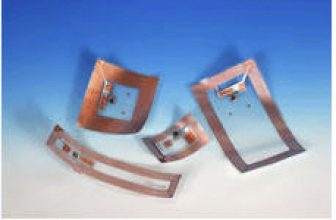
Application cases of RFID anti-counterfeiting identification and information storage technology in electronic delivery cards
[ad_1]
The promotional methods of the mooncake manufacturers in the Mid-Autumn Festival show their magical powers! Many of them use bills to promote group purchases, but anti-counterfeiting and information collection have always been problematic. The emergence of disposable RFID paper electronic tickets has solved the problem. The development of digital printing technology and traditional fast printing has made the forgery of traditional tickets easy. Improving the anti-counterfeiting technology of tickets not only provides protection for all types of tickets themselves, but also provides a more convenient way for the process of ticket sales, circulation and admission identification. At present, the industry is generally optimistic about the application potential of RFID radio frequency identification technology in ticket anti-counterfeiting.
Ticket anti-counterfeiting is mainly embodied in two aspects: one is that the ticket buyer can identify the authenticity by simple methods when buying the ticket; the second is that the ticket inspector can easily and quickly identify the authenticity when the audience enters the venue. The essence of the ticket anti-counterfeiting system lies in the use of ticket anti-counterfeiting technology, grasping the two key links of ticket anti-counterfeiting, and combining computer technology and communication technology to realize the anti-counterfeiting management of tickets. Compared with the current anti-counterfeiting technologies of traditional domestic tickets, such as ordinary color printing, anti-counterfeiting printing, bar codes, and anti-counterfeiting labels, RFID technology has obvious advantages in all aspects.
The ticket anti-counterfeiting system developed by using RFID technology is mainly composed of electronic tag anti-counterfeiting tickets, RFID reading equipment and RFID middleware. The system can help various ticketing agencies, large venues, and exhibition halls realize convenient and fast ticket sales and ticket checking, and can carry out real-time and accurate positioning and tracking of ticket holders.
Data Center: It is composed of a central data server and a management terminal. It is the data center of the system, which centrally stores and processes ticket management information, ticket sales and ticket checking information.
Ticketing/Ticketing System: It consists of a ticketing management terminal and a label issuing and printing terminal. Complete the unified production, sale and authenticity of electronic label tickets.
Ticket inspection/ticket inspection system: The ticket inspector can verify the authenticity of the ticket through the handheld device when the audience enters the venue. The list of legal spectators and the identification information of admission and tickets are uploaded and downloaded through the upper computer and the management center.
Ticket sales management
Ticket issuance: The ticket seller selects the type, unit price and validity period of the ticket to be sold, and completes the on-site delivery. The label issuing/printing terminal can write all the completed tickets to the IC and print it out;
Display the current ticket sales status;
Ticket identification terminal to verify the authenticity of tickets;
Submit ticket information to the server.
Ticket inspection management
When entering and exiting ticket inspection/ticket inspection, the handheld device reads the information of the electronic tag ticket, and performs safety certification through the list of legal personnel and the safety certification module. If the certification is passed, the information is read out correctly, the confirmation information is returned, the tag identification is modified, and the ticket is legally passed; otherwise, Prompt the alarm.
Download the list of legal spectators, enter the venue and ticket identification information.
Ticketing center management
Ticket management: The system can realize the unified storage of the basic information of the ticket, such as the name of the performance, venue, ticket price, discount, issuance date, etc.; provide information to assist in the reasonable arrangement of the ticket window, the ticket seller, etc.; comprehensively record the number of pre-collected tickets and the collection people.
Data collection and settlement: collect various ticketing information of the ticket sales and ticket inspection system; sort and settle the same day or each performance.
Equipment and system management: equipment information, authorization and configuration management and maintenance; system operator authorization and maintenance.Comprehensive statistics and query
On-site statistics of ticket sales for different sessions and various time periods;
Query statistics based on conditions such as ticket sales time, ticket location, ticket type, admission status, etc.;
Income statistics and query for each game, daily and monthly;
Print statistical reports of various data.
System Features
Economical and practical
The electronic label is composed of a chip with a certain storage capacity and a special antenna connection, and can be conveniently packaged in various media such as plain paper, self-adhesive paper, PVC, PET, PP, etc., with its excellent physical characteristics to provide effective anti-counterfeiting Function, and can avoid the reproducibility of existing barcodes and anti-counterfeiting labels. Embedding non-contact chips into low-cost, disposable paper media can meet the needs of cheap ticket and card solutions to the greatest extent. The application of this advanced technology can greatly reduce equipment investment and maintenance costs, and save other anti-counterfeiting technologies ( For example, the cost of laser, diffraction, etc.).
Quick scan for accessible reading
Compared with bar codes, RFID electronic tags do not need to be aligned and scanned, and the reading and writing speed is very fast. In addition, bar code scanners must be close and without obstructions to read bar codes, while RFID uses radio waves to transmit information without the problem of transmission barriers.
Security and flexibility
The inside of the non-contact paper ticket has a globally unique serial number and an application area that can be divided into independent areas, which can store different application data or cardholder information. The application area can be separately locked as read-only by setting the system bit after the ticket is issued, and different configuration methods can be used to meet the requirements of the corresponding security level. The system provides a variety of operating modes. For the organizer’s existing ticketing system, Tsinghua Tongfang provides an interface to realize the seamless connection between the ticket anti-counterfeiting system and the original system; if the organizer does not use the ticketing system, Tsinghua Tongfang’s ticket anti-counterfeiting system can operate independently .
Simple to implement and easy to use
Since the ticket production is done by Tsinghua Tongfang, the organizer gets the encapsulated tickets and ticket inspection equipment. Therefore, the installation and debugging of the system are simple, and the later operation and maintenance are also very simple and convenient. The system provides reliable performance and height. Security.
The system is very convenient both in ticket sales and ticket checking. In ticket sales, the original ticket format and production of the application site are not changed; in ticket checking, verification is convenient and fast. Ticket checking at the ticket gate can only be done with a handheld machine, which is convenient for people to pass through the ticket gate.
The RFID ticket anti-counterfeiting system is suitable for various events, performances and exhibition venues, as tickets for large-scale theatrical performances, exhibitions or fairs, sports competition tickets, various tickets, scenic spots annual tickets and travel coupons, etc.
[ad_2]




